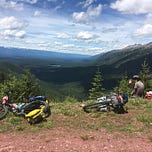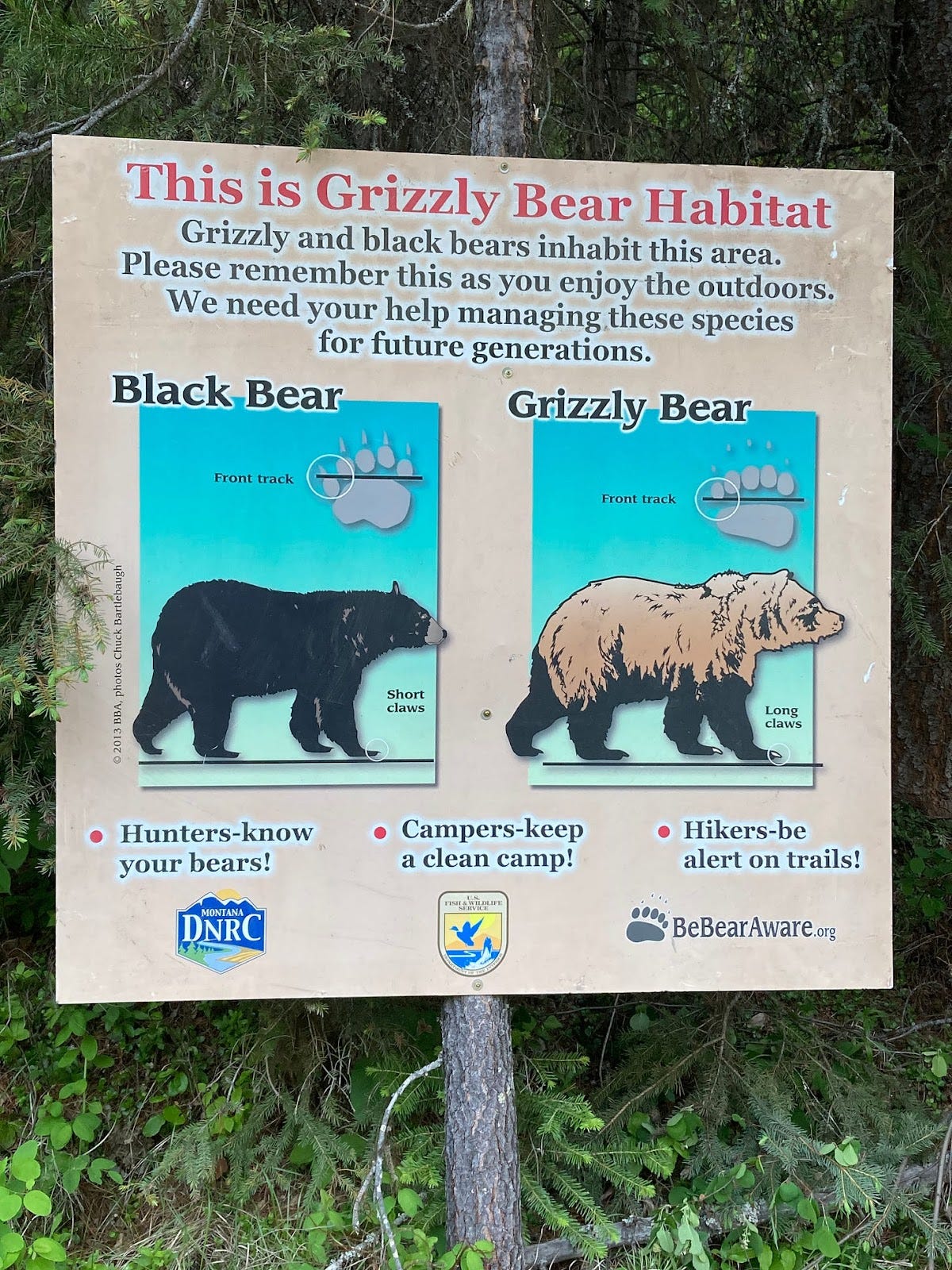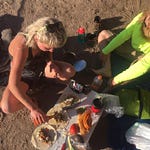Surviving a bear encounter on the Great Divide Mountain Bike Route
Authors note- I am sharing this information that is based on my experiences on the GDMBR and my education from a park ranger, Montana Fish and Game Wardens, and from the instructors at the Glacier Institute. My purpose is to educate Bikepackers on being responsible stewards for wildlife while traveling in Bear Country.
Bear country tactics (and other wildlife)
The first time that I rode part of the GDMBR I flew into Missoula Montana and rode my bike over to Seeley Lake, MT to connect with the Divide.
I stayed at the campground in Seeley Lake and there I met an ex National Park Ranger who worked in Alaska. He asked me if I was carrying bear spray and I told him I didn’t think I needed it and he proceeded to explain why I did need it. He shared a story of a Montana man who was mountain biking and surprised a grizzly (cause) and was killed (effect), in which Fish and Game had to euthanize the bear.
I bought bear spray.
Last summer, I based myself out of Polebridge, Montana in between the Flathead National Forest and Glacier National Park just 20 miles from the Canadian border. The Saloon I worked at had us go through bear training by the Glacier Institute where we actually were taught how to use bear spray by using inert bear spray. It’s important to go through that training and the two biggest things I learned was that you want to carry the bear spray on your body because if you get separated from the bicycle and the bear spray is on the bicycle, then it makes for even more of a dangerous situation. One can attach it to the strap of a Camelback, hip belt, or small backpack, and there are companies that sell bear spray holsters that are strapped to your chest. The instructors told me about an incident, where a young woman had the bear spray attached to her chest strap on her Camelback and had come around a corner and surprised a grizzly, and she fell off the bike trying to stop and was on the ground as the surprised grizzly charged her. She was able to reach up to the strap and unclip the safety and discharged the spray still in the holster, driving off the bear -not an ideal circumstance, but it did save her life.
Another thing I learned from the class is how to spray bear spray. If you feel threatened you spray it from hip to hip, a half circle basically at hip level, so whatever threat is approaching moves into the cloud of the spray and will immediately be deterred. The instructors recommend you carry two canisters, for obvious reasons. And do not accept old canisters as they can fail.
I am adding this from the Glacier Institute:
S.P.R.A.Y.-What’s this?
This is, by far, the most common question we hear from tourists and guests in Glacier National Park. “What do I do if I see a bear?” Well, let me tell you, the answer is simple if you can remember S.P.R.A.Y..
This quick, five-letter, mnemonic will give you the basic steps necessary to avoid bear conflicts in Glacier National Park. Before we get into it, however, it’s worth noting that we are entering bear country anytime we are in GNP. You need to have bear spray and know how to use it. Please refer to our online resources if you aren’t sure. You can purchase bear spray on arrival, or rent it from our good friends at Glacier Outfitters.
The reality is that too many people are avoiding going into the outdoors because of a fear of bears, and it doesn’t have to be this way. It shouldn’t be this way. Remembering a few easy tips will help you feel more comfortable hiking in bear country.
Alright, let’s get to it –
S – Stop.
Easy enough, right? The worst thing you can do is run. Bears have a tendency to chase, even if they don’t know why immediately.
P – Prepare your group.
Yes, it is best to hike in groups. A big part of this falls into the “antecedent arrangement” part of preparation, or setting yourself up for success. Plainly stated, groups make more noise and talk more. The human voice is the best bear deterrent. While we don’t say that hiking alone is wrong or terrible, we know that hiking in groups reduces your risk of negative bear encounters. Please note, I said “reduces,” not “eliminates.” I’ve seen plenty of bears while in large groups and what you do next is very important. You’ll want to gather your group together and make sure to calmly let them know of the situation. This is not to look big, but to be unified. It is easier for the bear to focus on one large group rather than a bunch of individuals, this will help reduce stress for the bear.
*Sidenote – If you do decide to hike alone, I would recommend talking to yourself audibly. This can be narrating your hike or singing opera, doesn’t matter. Better to look crazy to other hikers than not be heard by bears nearby.
**Other sidenote – “Hey, bear,” is not a good thing to say unless you are looking at a bear. This was incorrectly taught for a number of years. Take our online bear course to learn why.
R – Ready your bear spray.
Take your bear spray out of the holster and simply have it in your hands. This is one less step, should the bear start displaying undesirable behaviors. If you want to learn more about what those undesirable behaviors might look like, take our online bear safety class here. Please note – do not remove the safety clip from your bear spray until you are ready to fire. This stuff hurts like the dickens, and the last thing you want is to spray yourself or your group on accident. I know from first hand experience.
A – Act human.
The best deterrent for bears is the human voice. It’s been proven over and over again how essential it is to make sure the bear knows what you are. These bears have been around humans before, possibly with negative consequences involved. Talk to the bear in a calm voice. Don’t whistle, clap, scream, or yell. In general, if you are calm, it will help the bear to be calm. This is not a promise, just a common observation based on hundreds of bear encounters from our team.
Y – Yield to the bear.
Sometimes, they just want to use the trail just like us. If the bear is walking towards you calmly, it probably just wants you to get out of the way. Find a place where you can safely get as far off the trail as you can, without turning your back to the bear, and watch as the bear passes by. This is not uncommon, and makes for an amazing story. Just don’t put down the bear spray to take a picture, keep it at the ready.
I’ve lost track of how many bears I’ve seen in Glacier National Park, but have never had an experience with a bear acting aggressively. If you have the right knowledge and tools, you can mitigate risk and feel comfortable hiking in bear country. If reading this article instills more fear rather than comfort, consider joining us for a day hike. We not only take care of transportation, parking, and educating, but our knowledgeable staff go through extensive training with bear experts before hitting the trails. If you want to become more knowledgeable, take a look at our online resources and in-person bear safety courses.
*Disclaimer – Bears are wild animals. In my years of experience working with animals, the biggest thing to remember is that animal behavior is the “study of one.” Each individual is different. The minute you start using blanket statements about a species, you’ll be proven wrong. As far as behavior, there is no, “grizzly bears always…” or “grizzly bears will never….” Anyone who tells you otherwise is wrong. Be alert in bear country. They can wake up on the wrong side of the bed, just like you. Keep your bear spray easily accessible and know how to use it. Anthony Nelson, Executive Director.
My multiple times on the GDMBR I have seen other riders being irresponsible by not: making noise in bear country, not hanging their food, keeping food and other smelly bear attractants in their tent or on the bike while camped, and then having the spray in a hard to reach location. Additionally I read reports every year of bear spray being accidentally discharged while the rider is riding-keep the safety clip on.
And one thing that really concerns me is when I see a GDMBR taking pictures of bears in close proximity because they were not being noisy.
I admit I write this for the Bears, and the other critters who might be in a situation where they instinctively feel they have to defend their young, or themselves. The above spray discharge technique can be used for Grizzly and Black Bears (There is no such animal as a Brown bear), Mountain Lions, Moose, and for personal self-defense of human predators.
So, here is the Mountain Biking in Bear Country video from the Glacier Institute, and I would like to encourage you to watch all of their excellent videos.
Please be safe and help keep the wildlife alive!
Bill Poindexter
Link to all videos about Bear Safety from Glacier Institute
All images were borrowed from the internet or my own photos.
















Share this post